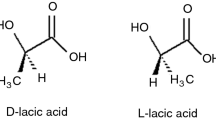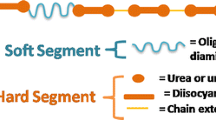Abstract
Novel hydrolytically degradable thermosensitive triblock copolymers with poly(ethylene glycol) (PEG) middle-chain and random copolymers of N-isopropylacrylamide and 5,6-benzo-2-methylene-1,3-dioxepane as side blocks were synthesized by the reversible addition–fragmentation chain transfer (RAFT) copolymerization of the two monomers in the presence of the bisester of [S-1-dodecyl-S′-(α,α′-dimethyl-α″-acetic acid)] trithiocarbonate and α,ω-dihydroxy PEG of 10,000 Da molecular weight as the RAFT macroagent. The polymers prepared were structurally characterized by gel permeation chromatography (GPC), 1H NMR and differential scanning calorimetry (DSC) analyses, and their thermosensitive behavior was evidenced by rheological measurements on 10 wt% aqueous solutions. The polymer aqueous solutions displayed enhanced viscosity at low temperatures due to the association of the hydrophobic dodecyl trithiocarbonate end groups, which was decreased by free radically removing the RAFT groups in the presence of tributyltin hydride. The gelation temperature, defined as the temperature at which the viscoelasticity moduli become equal each other, ranged between 36 and 43 °C depending on the aqueous solvent (distilled water or phosphate buffer saline (PBS)) and the presence of hydrophobic dodecyl end groups. The degradable character of the triblock copolymers prepared was proved by the hydrolysis of the in-chain ester groups in 1-N KOH solution at room temperature. A partial degradation of the polymer also occurred in the gel formed at 37 °C from a 10 wt% PBS solution, as proved by both GPC and 1H NMR measurements. Under these conditions, the gel completely dissolved and lost its thermogelation ability up to 60 °C in less than 24 days.








Similar content being viewed by others
References
Gil E, Hudson SH (2004) Stimuli-responsive polymers and their bioconjugates. Prog Polym Sci 29:1173–1222
Ruel-Gariepy E, Leroux JC (2004) In situ-forming hydrogels—review of temperature-sensitive systems. Eur J Pharm Biopharm 58:409–426
Crespy D, Rossi RM (2007) Temperature-responsive polymers with LCST in the physiological range and their applications in textiles. Polym Int 56:1461–1468
Guenther M, Gerlach G, Corten C, Kukling D, Müller M, Shi Z, Soerber J, Arndt KF (2007) Application of polyelectrolytic temperature-responsive hydrogels in chemical sensors. Macromol Symp 254:314–321
Zhang X, Zhou L, Zhang X, Dai H (2010) Synthesis and solution properties of temperature-sensitive copolymers based on NIPAM. J Appl Polym Sci 116:1099–1105
Lu W, Zhao B, Li N, Yao Y, Chen W (2010) Thermosensitive copolymer with cobalt phthalocyanine and catalytic behavior based on adjustable LCST. React Func Polym 70:135–141
Li Z, Guan J (2011) Thermosensitive hydrogels for drug delivery. Expert Opin Drug Deliv 8:991–1007
Huynh CT, Nguyen MK, Lee DS (2011) Injectable block copolymer hydrogels: achievements and future challenges for biomedical applications. Macromolecules 44:6629–6636
Buenger D, Topuz F, Groll J (2012) Hydrogels in sensing applications. Prog Polym Sci 37:1678–1719
Toh WS, Loh XJ (2014) Advances in hydrogel delivery systems for tissue engineering. Mater Sci Eng C 45:690–697
Overstreet DJ, Dutta D, Stabenfeldt SE, Vernon BL (2012) Injectable hydrogels. J Polym Sci Part B: Polym Phys 50:881–903
Ko DY, Shinde UP, Yeon B, Jeong B (2013) Recent progress of in situ formed gels for biomedical applications. Prog Polym Sci 38:672–701
Yang JA, Yeom J, Hwang BW, Hoffman AS, Hahn SK (2014) In situ-forming injectable hydrogels for regenerative medicine. Prog Polym Sci 39:1973–1986
Singh NK, Lee DS (2014) In situ gelling pH- and temperature-sensitive biodegradable block copolymer hydrogels for drug delivery. J Control Release 193:214–227
Schild HG (1992) Poly(N-isopropylacrylamide): experiment, theory and application. Prog Polym Sci 17:163–249
Lutz JF, Akdemir O, Hoth A (2006) Point by point comparison of two thermosensitive polymers exhibiting similar LCST: is the age of poly(NIPAM) over? J Am Chem Soc 128:13046–13047
Neradovic DJ, Hinrichs WL, van den Bosch JJ K, Hennink WE (1999) Poly(N-isopropylacrylamide) with hydrolyzable lactic acid ester side groups: a new type of thermosensitive polymer. Macromol Rapid Commun 20:577–581
Lee BH, Vernon B (2005) Copolymers of N-isopropylacrylamide, HEMA-lactate and acrylic acid with time dependent lower critical solution temperature as a bioresorbable carrier. Polym Int 54:418–422
Lee BH, Vernon B (2005) In situ-gelling, erodible N-isopropylacrylamide copolymers. Macromol Biosci 5:629–635
Guan J, Hong Y, Ma Z, Wagner WR (2008) Protein-reactive, thermoresponsive copolymers with high flexibility and biodegradability. Biomacromolecules 9:1283–1292
Wang F, Li Z, Khan M, Tamama K, Kuppusamy P, Wagner WR, Sen CK, Guan J (2010) Injectable, rapid gelling and highly flexible hydrogel composites as growth factor and cell carriers. Acta Biomater 6:1978–1991
Cui Z, Lee BH, Pauken C, Vernon BL (2011) Degradation, cytotoxicity, and biocompatibility of NIPAAm-based thermosensitive, injectable, and bioresorbable polymer hydrogels. J Biomed Mat Res 98A:159–166
Sun LF, Zhuo RX, Liu ZL (2003) Studies on the synthesis and properties of temperature responsive and biodegradable hydrogels. Macromol Biosci 3:725–728
Ren L, Agarwal S (2007) Synthesis, characterization and properties evaluation of poly[(N-isopropylacrylamide)-co-ester]s. Macromol Chem Phys 208:245–253
Galperin A, Long TJ, Ratner BD (2010) Degradable, thermosensitive poly(N-isopropylacrylamide)-based scaffolds with controlled porosity for tissue engineering applications. Biomacromolecules 11:2583–2592
Siegwart DJ, Bencherif SA, Srinivasan A, Hollinger JO, Matyjaszewski K (2008) Synthesis, characterization, and in vitro cell culture viability of degradable poly(N-isopropylacrylamide-co-5,6-benzo-2-methylene-1,3-dioxepane)-based polymers and crosslinked gels. J. Biomed Mater Res A 87:345–358
Mizuntani M, Satoh K, Kamigaito M (2011) Degradable poly(N-isopropylacrylamide)with tunable thermosensitivity by simultaneous chain- and step-growth radical polymerization. Macromolecules 44:2382–2386
Han CK, Bae YH (1998) Inverse thermally-reversible gelation of aqueous N-isopropylacrylamide copolymer solutions. Polymer 39:2809–2814
Teodorescu M, Negru I, Stanescu PO, Draghici C, Lungu A, Sarbu A (2010) Thermogelation properties of poly(N-isopropylacrylamide)-block-poly(ethylene glycol)-block-poly(N-isopropylacrylamide) triblock copolymer aqueous solutions. React Func Polym 70:790–797
Overstreet DJ, McLemore RY, Doan BD, Farag A, Vernon BL (2013) Temperature-responsive graft copolymer hydrogels for controlled swelling and drug delivery. Soft Materials 11:294–304
Shim MS, Lee HT, Shim WS, Park I, Lee H, Chang T, Kim SW, Lee DS (2002) Poly(D, L-Lactic acid-co-glycolic acid)-b-poly(ethylene glycol)-b-poly(D, L-lactic acid-co-glycolic acid) triblock copolymer and thermoreversible phase transition in water. J Biomed Mater Res 61:188–196
Taktak FF, Bütün V (2010) Synthesis and physical gels of pH- and thermo-responsive tertiary amine methacrylate based ABA triblock copolymers and drug release studies. Polymer 51:3618–3626
De Graaf AJ, Boere KWM, Kemmink J, Fokkink RG, Van Nostrum CF, Rijkers DTS, Van der Gucht J, Wienk H, Baldus M, Mastrobattista E, Vermonden T, Hennink WE (2011) Looped structure of flowerlike micelles revealed by 1H NMR relaxometry and light scattering. Langmuir 27:9843–9848
Chassenieux C, Nicolai T, Benyahia L (2011) Rheology of associative polymer solutions. Curr Opin Colloid Interface Sci 16:18–26
Wickel H, Agarwal S (2003) Synthesis and characterization of copolymers of 5,6-benzo-2-methylene-1,3-dioxepane and styrene. Macromolecules 36:6152–6159
You YZ, Oupicky D (2007) Synthesis of temperature-responsive heterobifunctional block copolymers of poly(ethylene glycol) and poly(N-isopropylacrylamide). Biomacromolecules 8:98–105
Lu F, Luo Y, Li B, Zhao Q, Schork FJ (2010) Synthesis of thermosensitive nano-capsules via inverse miniemulsion polymerization using PEO-RAFT agent. Macromolecules 43:568–571
Agarwal S (2010) Chemistry, chances and limitations of the radical ring-opening polymerization of cyclic ketene acetals for the synthesis of degradable polyesters. Polym Chem 1:953–964
Bailey WJ, Ni Z, Wu SR (1982) Free radical ring-opening polymerization of 4,7-dimethyl-2-methylene-1,3-dioxepane and 5,6-benzo-2-methylene-1,3-dioxepane. Macromolecules 15:711–714
Huang J, Gil R, Matyjaszewski K (2005) Synthesis and characterization of copolymers of 5,6-benzo-2-methylene-1,3-dioxepane and n-butyl acrylate. Polymer 46:11698–11706
Lutz JF, Andrieu J, Uzgun S, Rudolph C, Agarwal S (2007) Biocompatible, thermoresponsive, and biodegradable: simple preparation of “all-in-one” biorelevant polymers. Macromolecules 40:8540–8543
Zhang Y, Zheng M, Kissel T, Agarwal S (2012) Design and biophysical characterization of bioresponsive degradable poly(dimethylaminoethyl methacrylate) based polymers for in vitro DNA transfection. Biomacromolecules 13:313–322
Kobben S, Ethirajan A, Junkers T (2014) Synthesis of degradable poly(methyl methacrylate) star polymers via RAFT copolymerization with cyclic ketene acetals. J Polym Sci Part A: Polym Chem 52:1633–1641
Gomez d’Ayala G, Malinconico M, Laurienzo P, Taedy A, Guillaneuf Y, Lansalot M, D’Agosto F, Charleux B (2014) RAFT/MADIX copolymerization of vinyl acetate and 5,6-benzo-2-methylene-1,3-dioxepane. J Polym Sci Part A: Polym Chem 52:104–111
Odian G (2004) Principles of polymerization, Fourthth edn. J. Wiley and Sons, Hoboken, New Jersey
Stanescu PO, Cursaru B, Teodorescu M (2009) Thermal properties of networks prepared from α, ω-diepoxy terminated poly(ethylene glycol)s and aliphatic polyamines. Mater Plast 46:419–425
Negru I, Teodorescu M, Stanescu PO, Draghici C, Lungu A, Sarbu A (2013) Thermogelation properties of ABA triblock copolymers of poly(ethylene glycol) (B) and copolyacrylates of oligo(ethylene glycol)s (A) in aqueous solution. Soft Materials 11:149–156
Stanescu PO, Turturica G, Andrei M, Draghici C, Vuluga DM, Zaharia A, Sarbu A, Teodorescu M (2015) Kinetic study upon the thermal degradation of poly(N-isopropylacrylamide-co-5,6-benzo-2-methylene-1,3-dioxepane) statistical copolymers. Mater Plast 52:193–197
Moad G, Rizzardo E, Thang SH (2011) End-functional polymers, thiocarbonylthio group removal/transformation and reversible addition-fragmentation-chain transfer (RAFT) polymerization. Polym Int 60:9–25
Zhang Y, Furyk S, Bergbreiter DE, Cremer PS (2005) Specific ion effects on the water solubility of macromolecules: PNIPAM and the Hohmeister series. J Am Chem Soc 127:14505–14510
Xia Y, Yin X, Burke NAD, Stöver HDH (2005) Thermal response of narrow-disperse poly(N-isopropylacrylamide) prepared by atom transfer radical polymerization. Macromolecules 38:5937–5943
Patel T, Ghosh G, Yusa S, Bahadur P (2011) Solution behavior of poly(N-isopropylacrylamide) in water: effect of additives. J Disp Sci Technol 32:1111–1118
Acknowledgments
This work was supported by a grant of the Ministry of National Education, CNCS–UEFISCDI, project number PN-II-ID-PCE-2012-4-0082.
Author information
Authors and Affiliations
Corresponding author
Ethics declarations
Conflict of interest
The authors declare that they have no conflict of interest.
Electronic supplementary material
Below is the link to the electronic supplementary material.
ESM 1
(PDF 332 kb)
Rights and permissions
About this article
Cite this article
Turturicǎ, G., Andrei, M., Stǎnescu, P.O. et al. ABA triblock copolymers of poly(N-isopropylacrylamide-co-5,6-benzo-2-methylene -1,3-dioxepane) (A) and poly(ethylene glycol) (B): synthesis and thermogelation and degradation properties in aqueous solutions. Colloid Polym Sci 294, 743–753 (2016). https://doi.org/10.1007/s00396-016-3831-9
Received:
Revised:
Accepted:
Published:
Issue Date:
DOI: https://doi.org/10.1007/s00396-016-3831-9




